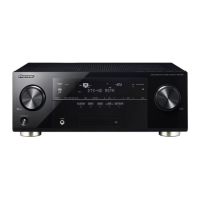
Do you have a question about the Pioneer VSX-1021-K and is the answer not in the manual?
| Impedance | 8 Ω |
|---|---|
| Frequency range | 20 - 20000 Hz |
| RMS rated power | - W |
| Audio output channels | 7.1 channels |
| Signal-to-Noise Ratio (SNR) | 81 dB |
| Total Harmonic Distortion (THD) | 0.05 % |
| Display | - |
| Product color | Black |
| Audio decoders | Dolby Digital Plus, Dolby Pro Logic IIz, Dolby TrueHD, DTS Neo:6, DTS-HD |
| HDMI in | 5 |
| Digital audio optical in | 2 |
| Ethernet LAN (RJ-45) ports | 1 |
| Multichannel audio input type | Terminals |
| Headphone outputs | 9 |
| Headphone connectivity | 3.5 mm |
| Connectivity technology | Wired |
| Audio formats supported | AAC, FLAC, MP3, WAV, WMA |
| Image formats supported | JPG |
| Video formats supported | MPEG4 |
| AM band range | 530 - 1700 kHz |
| FM band range | 87.5 - 108 MHz |
| Supported radio bands | AM, FM |
| Preset stations quantity | 63 |
| Supported video modes | 1080p |
| Dimensions (WxDxH) | 435 x 362.5 x 168 mm |
| HDMI ports quantity | 6 |
| AC input voltage | 120 V |
| AC input frequency | 60 Hz |
| Power consumption (standby) | 0.3 W |
| Power consumption (typical) | 550 W |
| Weight | 10000 g |
|---|
Details benefits like protecting investment, receiving tips, and improving product development.
Record model and serial numbers for future reference on the warranty card.
Includes FCC regulations, household use limits, hearing safety, and hot surface warnings.
Verify all supplied accessories are present before proceeding with installation.
Instructions on how to insert batteries into the remote control for initial operation.
Explains factors that can affect the remote control's operation and range.
Steps to disable the default demo mode displayed on the front panel.
Information on controlling the receiver using a mobile terminal app.
Guide to using the AVNavigator CD-ROM for interactive setup and features.
Information on operating environment and precautions for using the AVNavigator CD-ROM.
How to launch and use the AVNavigator application and its functions.
Instructions on how to uninstall the AVNavigator software from your PC.
Explanation of the remote control's buttons and their functions, color-coded by component.
Buttons for accessing receiver settings like Audio, Video, Home Menu, and Return.
Buttons used for navigating menus and confirming selections.
Buttons to select different listening modes like Auto Surround and Stereo.
Indicator light for command transmission and dedicated TV control buttons.
Controls for adjusting listening volume and muting audio output.
Indicators showing the currently selected input signal, including Auto.
Lights indicating channels receiving digital signals like L/R, C, SL/SR, LFE.
Lights showing detected digital signal formats like Dolby Digital, DTS.
Indicators for Multi-Zone, Sound, Sound Retriever, Phase Control, and analog signal level.
Indicators for tuning status, stereo reception, mute, and master volume level.
Indicators for selected input functions and current speaker system settings.
Indicators for sleep mode and matrix decoding formats like Dolby Pro Logic IIx.
Display for system information and indicator for remote control mode.
Standby/On button, input selector dial, and indicators for MCACC, FL OFF, HDMI, and iPod.
Controls for managing multi-zone operations and the front panel character display.
Buttons for tuning radio stations, editing presets, and selecting bands.
Remote sensor, master volume dial, and speaker terminal selection controls.
Headphone jack and buttons for selecting listening modes like Auto Surround.
Microphone jack for MCACC setup and front panel audio/video input terminals.
USB terminals for Apple devices and the Sound Retriever Air function button.
Button to enable direct iPod operation from the iPod itself.
Diagram of the receiver's rear panel showing various input and output terminals.
Table showing default assignments of input functions to input terminals.
Guide to configuring speaker systems based on the number and type of speakers used.
Diagrams illustrating various surround sound system connection configurations (A, B, C).
General advice on speaker placement and room acoustics for better sound.
How to connect for 5.1 surround sound in the main zone and stereo in ZONE 2.
Configuration for 5.1 surround sound with bi-amping for enhanced front speaker performance.
Notes on connecting fewer than 5.1 speakers or when not connecting a subwoofer.
How to connect speaker wires to the receiver's positive and negative terminals.
Step-by-step guide for making secure bare wire connections to speaker terminals.
Method for connecting speaker cables terminated with banana plugs.
General guidance on installing speakers and connecting them to the receiver.
Diagrams illustrating various surround sound system connection configurations (A, B, C).
Instructions on how to bi-wire speakers for improved sound quality.
Guide to selecting speaker system settings for front height, front wide, and Speaker B.
Instructions for setting up ZONE 2 for simultaneous main zone and sub zone audio.
Overview of cable types (HDMI, Coaxial, Optical, Analog) and signals they transfer.
Explanation of how HDMI cables transfer audio and video signals simultaneously.
Explanation of the video converter's function and limitations for outputting video sources.
Details on HDMI technology, supported functions, and digital audio/video formats.
Guide on connecting components via HDMI, including Control with HDMI features.
Visual representation of connecting components using HDMI cables to the receiver and TV.
Explanation of using ARC for TV audio output via HDMI and required setup.
How to connect a DVD player lacking HDMI output using alternative video connections.
Instructions for connecting a TV that does not have an HDMI input.
Diagram showing how to connect HDD/DVD recorders and BD recorders to the receiver.
Note on using analog audio cables for recording, as digital is for playback only.
Recommendation to use HDMI for connecting recorders with HDMI output.
Diagram illustrating connections for satellite/cable receivers and set-top boxes.
Recommendation to use HDMI for connecting set-top boxes with HDMI output.
Diagram showing how to connect CD-R, MD, DAT, and other audio components.
Note on connecting analog audio outputs for recorders and turntable line-level outputs.
Illustration showing how to connect the AM loop and FM wire antennas.
Instructions for connecting an external FM antenna for improved reception.
Method for improving AM reception by connecting an external wire antenna.
Explanation of how MULTI-ZONE allows independent operation in separate rooms.
Requirements for making MULTI-ZONE connections, including separate TVs and amplifiers.
Table showing available input signals that can be output to ZONE 2.
Steps for basic setup using audio zone 2 out jacks and video zone 2 out jack.
Alternative MULTI-ZONE setup using surround back speaker terminals.
Instructions for connecting a SIRIUS Satellite Radio tuner for satellite broadcasts.
Diagram illustrating network connection via LAN terminal to a router and PC.
Information on using the LAN terminal for Internet radio and Home Media Gallery.
Details on the LAN terminal's Ethernet jack type and speed.
Steps to connect the Bluetooth ADAPTER to the receiver's ADAPTER PORT.
Information on device compatibility, A2DP profiles, and Pioneer's guarantee for Bluetooth devices.
How to connect an iPod to the receiver's dedicated iPod terminal using the supplied cable.
Details on compatible iPod models, software versions, and potential limitations.
How to connect USB devices for audio/photo playback or use as a keyboard.
Notes on USB hub incompatibility and file format support for USB devices.
How to use the standard audio/video jacks on the front panel for connections.
Information on using the optional AS-WL300 for wireless LAN connection.
Diagram showing the wireless LAN converter connected to the receiver and router.
How to use an IR receiver for controlling components in closed cabinets or other zones.
Diagram showing how to connect the IR receiver sensor to the IR IN jack.
Notes on remote operation interference and terminology differences.
How SR CONTROL jacks link components for unified remote control.
Note on how the IR receiver sensor takes priority over the front panel sensor.
Safety instructions for handling the power cord to prevent electric shock or fire.
Instructions for plugging the AC power cord into a convenient outlet.
Explanation of the HDMI initialization process upon connecting AC power.
Steps to change the on-screen display language for the Graphical User Interface.
Guide to performing automatic sound tuning using Full Auto MCACC.
How to connect the MCACC setup microphone to the front panel jack.
Explanation of parameters to set before Auto MCACC, like Speaker System and EQ Type.
Troubleshooting common issues during Auto MCACC setup, like ambient noise.
Steps to access the Input Setup menu via HOME MENU and System Setup.
How to select and set up input functions for connected components.
How to access and select the operation mode (Expert or Basic).
Steps to access the Operation Mode Setup menu via HOME MENU.
Choosing between Expert mode (full control) and Basic mode (restricted functions).
List of functions and their descriptions/pages for both Expert and Basic modes.
Basic steps for playing a source, including switching on components and selecting inputs.
Notes on checking digital audio output settings on source components for optimal playback.
How to play sources connected via HDMI, including audio settings.
Introduction to playing audio content from an iPod using the receiver's controls.
Compatibility information, software version notes, and licensing for iPod playback.
How to navigate and play music files from an iPod using the GUI screen.
Methods for browsing iPod music by playlist, artist, album, etc.
How to switch control between the iPod itself and the receiver's remote.
Steps to connect and have the receiver recognize a USB device.
Information on compatible USB devices and handling over current errors.
How to navigate and play audio files stored on a USB memory device.
How to display and play back photo files from a USB memory device as a slideshow.
List of supported music file formats (MP3, WAV, WMA, AAC) and their specifications.
Details on supported photo file formats (JPEG) and their requirements for playback.
Instructions for tuning FM/AM radio stations using automatic and manual methods.
How to use the MPX function to switch to mono reception for weak FM signals.
Activating Neural Surround for enhanced FM radio surround sound.
Method for directly tuning to a radio station using frequency input.
How to memorize and store up to 63 radio stations in seven banks.
How to recall saved radio stations using preset class and number selection.
How to assign custom names to saved station presets for easier identification.
Steps to save up to 63 SIRIUS channels into seven memory classes.
How to recall and listen to saved SIRIUS channels using preset classes.
Accessing additional SIRIUS Radio features via the SIRIUS Menu.
How to enjoy music wirelessly using the Bluetooth ADAPTER and enabled devices.
Using the remote control to play and stop media from Bluetooth devices.
Step-by-step guide for pairing Bluetooth devices with the receiver via the ADAPTER PORT.
Selecting or entering a passcode for Bluetooth device pairing.
Following GUI instructions to conduct pairing with a Bluetooth wireless technology device.
Confirmation that the Bluetooth ADAPTER is detected by the wireless technology device.
Selecting the Bluetooth ADAPTER from the device list and entering the passcode.
Pressing ADPT to switch the receiver to the ADAPTER PORT input.
Performing the operation to connect the Bluetooth device to the Bluetooth ADAPTER.
Beginning playback of music content stored on the Bluetooth wireless technology device.
Setting the listening mode to SOUND RETRIEVER AIR while listening.
Notes on listening modes, features, and receiver status dependency.
Using Auto Surround to automatically select playback mode based on source.
How Neural Surround works with FM radio and ALC equalizes playback sound levels.
General information on listening to any source in surround sound, depending on setup.
Description of basic surround sound modes for stereo and multichannel sources.
Details on various surround sound modes like Pro Logic IIx MOVIE/MUSIC/GAME and Neo:6 CINEMA/MUSIC.
Explanation of STEREO mode and Straight Decode for playback without effects.
Using advanced surround effects like ACTION and DRAMA for movie soundtracks.
Bypassing signal processing for pure analog or digital sound source reproduction.
How to select modes like AUTO SURROUND, ALC, and DIRECT.
Explanation of PURE DIRECT mode for minimal processing and no Speaker B output.
How to switch between saved MCACC presets for different listening positions.
List of digital signal formats supported by the receiver (Dolby Digital, DTS, PCM, HDMI).
How to prevent digital noise by making proper digital connections and settings.
How Phase Control uses phase correction for optimal sound image and prevents distortion.
Steps to switch on phase correction using the PHASE CTRL button.
Important notes on phase matching, subwoofer phase control, and low-pass filter settings.
Cases where the PHASE CONTROL mode cannot be set to ON (PURE DIRECT, HDMI THROUGH).
Overview of the Home Media Gallery function for listening to audio files and Internet radio.
Features enabled by the receiver's LAN terminal for network playback.
How to play music files stored on PCs using the unit.
How to select and listen to Internet radio stations via the vTuner service.
Explanation of DLNA network devices and how the receiver functions as a Digital Media Renderer (DMR).
Requirement to turn on the router's DHCP server function for network playback.
Steps for authorizing the receiver to access PCs on the network for playback.
Important points to remember when playing back audio files or accessing the network.
How to select Home Media Gallery as the input function to access network sources.
How to select categories like Internet Radio, Server Name, or Favorites.
How to save Internet radio stations into seven classes (A-G) with up to nine stations each.
How to recall saved Internet radio stations from memory.
Steps to register external broadcast stations via a special Pioneer website.
How to register and play up to 20 favorite songs or Internet radio stations.
Operations for playing back audio files stored on network components using the remote control.
Detailed guide on how Internet radio works and how to listen to stations by genre or region.
Information about the vTuner database service that manages the Internet radio station list.
Explanation of technologies used for network playback, including Windows Media Player and DLNA.
Notes on file format compatibility and limitations for network playback.
Disclaimer regarding warranties and liability for third-party content services.
Information on potential issues like playback stalling or interruptions during network operation.
Detailed list of supported music file formats (MP3, WAV, WMA, AAC) and their specifications.
Details on supported photo file formats (JPEG) and their requirements for playback.
Explanation of synchronized operations using Control with HDMI-compatible devices.
How to connect TVs and components for synchronized operation via HDMI.
Note on the HDMI initialization process and how to skip it.
Important notes on using Control with HDMI with Pioneer and other brands.
Adjusting settings for Control with HDMI, including Control Mode and Display Power Off.
Enabling or disabling the Control with HDMI function for the receiver.
Selecting how Control with HDMI functions are applied (ALL or PQLS).
Enabling or disabling the receiver power-off function when the TV turns off.
Setting the standby mode for power saving or faster startup.
Configuring TV audio output via HDMI using the ARC function.
Using Control with HDMI with non-Pioneer TVs and players, and potential limitations.
Explanation of PQLS for jitter-free audio playback via HDMI.
Compatibility information for PQLS with different player types and audio settings.
How to activate PQLS and select its settings (AUTO/OFF).
How to access and adjust various sound settings via the AUDIO PARAMETER menu.
Detailed list of audio settings like TONE, BASS, TREBLE, S.RTRV, DNR, DIALOG E, DUAL, Fixed PCM, DRC.
Selecting favorite MCACC preset memories for different listening scenarios.
Adjusting audio delay to synchronize sound with picture, especially for video.
Enhances SACD detail by maximizing dynamic range during digital processing.
Specifies routing of HDMI audio signal to receiver's amp or TV, with THROUGH option.
Automatically corrects audio-to-video delay for connected components.
Blends center channel between front speakers for wider sound image.
Adjusts surround sound balance depth from front to back for a more distant or forward sound.
Extends front stereo image to include surround speakers for a wraparound effect.
Adjusts center image for wider stereo effect with vocals, sending center channel to front/left speakers.
Sets the effect level for selected Advanced Surround or ALC modes.
How to access and adjust picture settings via the VIDEO PARAMETER menu.
Detailed list of video settings like V.ADJ, YNR, DETAIL, SHARP, BRIGHT, CONTRAST, HUE, CHROMA, BLK SETUP, ASP.
Converts video signals for output from monitor jacks, including HDMI OUT.
Specifies output resolution for video signals, selectable for HDMI output.
Optimizes progressive scanning circuit for film playback, adjustable to AUTO, ON, or OFF.
Adjusts motion and still picture quality for progressive video output.
How to switch between speaker systems using the SPEAKERS button for different settings.
Settings for Normal (SB/FH) mode, including surround back/front height options.
Settings for Normal (SB/FW) mode, including surround back/front wide options.
Settings for using Speaker B terminals for stereo playback in another room.
How to switch the MULTI-ZONE feature on or off using the front panel button.
Adjusting sub zone volume and selecting sources using front panel controls.
Table showing available remote control functions for ZONE 2 operation.
Steps for making recordings from tuner or connected sources, including component connection.
Important notes on digital vs. analog recording, copy protection, and video cable types.
Explanation of items within the Remote Setup menu for controlling other components.
How to operate up to four receivers of the same model using one remote control.
Steps to enter 4-digit preset codes for controlling other components.
Assigning input function buttons to control other components via preset codes.
How to erase a programmed button and restore it to factory default.
How to erase all operational settings for other devices programmed for one input function.
Using direct function to control one component while playing another.
Programming sequences for starting listening or shutting down components.
Steps to program sequences for multi-operation or system shutdown.
How to execute programmed multi-operation sequences.
How to execute programmed system shutdown sequences.
Table of preset codes for controlling various components like TV, DVD, BD, etc.
Table detailing remote control functions for TV and Audio/Video components.
Table detailing remote control functions for Audio/Video components like LD, CD, MD, Cassette Deck.
Table detailing remote control functions for TV projector settings.
Overview of using the Advanced MCACC menu for studio-level sound field adjustments.
Guide to performing detailed MCACC setup for custom calibration options.
Selecting parameters to set in the Auto MCACC menu, such as Auto MCACC, EQ Type, THX Speaker.
How to connect the MCACC setup microphone to the front panel jack.
Steps for following on-screen instructions during the Auto MCACC setup process.
Checking the displayed speaker configuration against the actual setup.
Steps after completing the Auto MCACC setup, including disconnecting the microphone.
Selecting 'Manual MCACC' from the Advanced MCACC menu to start detailed adjustments.
Overview of manual setup settings: Fine Channel Level, Fine SP Distance, Standing Wave, EQ Adjust.
Adjusting speaker channel levels for overall sound balance, using test tones.
Making precise delay settings for speakers to ensure sound arrives simultaneously.
Controlling overly resonant low frequencies using filters for MCACC presets.
Manually adjusting speaker system frequency balance using test tones.
Minimizing room reverberation effects by calibrating based on direct speaker sound.
Steps for using EQ Professional, including Reverb Measurement and View.
Displaying speaker size, number, and settings for MCACC presets.
Displaying the output level of various channels for selected MCACC presets.
Displaying speaker distances from the listening position for selected MCACC presets.
Displaying standing wave related adjustment values for MCACC memories.
Displaying calibration values for frequency response of channels in MCACC presets.
Storing, copying, renaming, and clearing MCACC presets for different listening positions.
How to rename MCACC presets for easier identification.
Copying settings from one MCACC preset to another, including all data or specific settings.
Removing unused MCACC presets from memory to free up space.
Overview of changing speaker settings, input assignments, OSD language, and network setup.
Detailed speaker setup adjustments for surround sound performance optimization.
Selecting speaker system configurations like Normal, Speaker B, Front Bi-Amp, or ZONE 2.
Specifying speaker configuration, size, number, and crossover frequency for MCACC presets.
Specifying speaker distances for proper sound depth and separation.
Adjusting tonal balance for cinema soundtracks to restore proper tone in large rooms.
Steps for setting up the network to listen to Internet radio and access other network functions.
Configuring IP address and proxy settings for network connectivity.
Entering the subnet mask provided by your ISP for network connection.
Entering the IP address of the gateway (router) connected to the receiver.
Entering DNS server addresses provided by your ISP for network access.
Entering proxy server IP address and port number for Internet access.
Changing the receiver's name as displayed on connected network devices.
Setting restrictions for Internet services and managing the parental lock password.
Connecting and configuring a wireless LAN converter for wireless network functions.
Making connection settings for the wireless LAN converter and access point.
Setting a specific IP address for the wireless LAN converter if needed.
Viewing network status, including IP address, MAC address, Friendly Name, and SSID.
Setting the receiver to turn off automatically after a period of inactivity or no signal.
Adjusting volume-related operations, including power-on level and volume limit.
Setting the receiver's remote control mode to prevent erroneous operation with multiple units.
Adjusting GUI screen resolution to improve visibility, without affecting video output.
Pairing a Bluetooth ADAPTER with a Bluetooth wireless technology device.
Updating the receiver's software via Internet or USB memory device.
Troubleshooting problems related to the receiver not turning on, not turning off, or switching off suddenly.
Troubleshooting when the unit does not respond to button presses or shows error messages.
Troubleshooting problems with no sound output from speakers or from specific inputs.
Troubleshooting no sound from surround or center speakers, checking settings and connections.
Troubleshooting no sound from specific speaker configurations, checking settings.
Troubleshooting low subwoofer output, checking settings and connections.
Troubleshooting no sound from a single speaker, checking connections and level settings.
Troubleshooting sound output issues related to analog versus digital sources.
Troubleshooting noise or output issues when playing Dolby Digital/DTS software.
Troubleshooting no sound when the Home Menu is selected.
Explanation of clicking sounds during speaker switching and how to manage them.
Troubleshooting issues with automatic station selection or noise in radio broadcasts.
Troubleshooting errors during AVNavigator installation due to system resources or incompatibilities.
Troubleshooting problems with software updates, including provider network issues.
Troubleshooting AVNavigator not interacting well with the receiver due to network settings.
Explanation of browser security warnings when launching AVNavigator functions.
Troubleshooting issues where folders/files on USB devices are not displayed.
Troubleshooting recognition problems with USB memory devices.
Troubleshooting issues where audio files from USB devices cannot be played back.
Troubleshooting USB keyboard detection, text entry, and layout compatibility.
Troubleshooting network access problems, including LAN cable and router connection issues.
Troubleshooting playback not starting or displaying 'Connecting...' indefinitely.
Troubleshooting issues accessing components connected to the network.
Troubleshooting audio playback being stopped or disturbed due to network traffic or controller operation.
Troubleshooting issues accessing Windows Media Player 11 or 12 due to domain login.
Troubleshooting wireless LAN connection failures between converter and router.
Troubleshooting WLAN POW ERR messages related to wireless LAN converter power supply.
Troubleshooting inability to listen to Internet radio stations due to firewall settings or disconnection.
Troubleshooting SIRIUS radio messages like Antenna Error, Acquiring Signal, and Firmware Updating.
Guidance on routing HDMI signals through the receiver and alternative connection configurations.
Connecting components via component video cables and converting to HDMI signal.
Connecting components directly to the display via HDMI and sending audio separately.
Instructions for cleaning the receiver's exterior using a polishing cloth or diluted cleanser.
Explanation of Dolby technologies like Dolby Digital, TrueHD, Digital Plus, and Surround EX.
Explanation of DTS technologies like Digital Surround, HD Master Audio, HD High Resolution, and DTS-ES.
Information on Apple's 'Made for iPod/iPhone/iPad' program and compatibility.
Information about SIRIUS Satellite Radio service and related trademarks.
Details about the FLAC Decoder and its licensing and redistribution terms.
Charts showing hearing output for stereo signals based on input format and speaker connection.
Charts showing hearing output for multichannel signals based on input format and speaker connection.
Descriptions of audio formats like Dolby, DTS, and their decoding technologies.
Explanation of features like Phase Control, Virtual Surround Back, Virtual Height, Auto Sound Retriever.
Explanation of PQLS for jitter-free high-quality audio playback via HDMI.
How ALC equalizes playback sound levels for optimal listening, especially at night.
Enjoying surround sound effects using only front speakers without compromising quality.
Description of MCACC for quick and accurate surround sound setup with advanced features.
Explanation of Control with HDMI function for synchronized operations with compatible devices.
Using ARC for TV audio output via HDMI, allowing single cable connection.
Explanation of DLNA for easy digital media sharing across home networks.
Information about vTuner, a paid service for listening to radio and TV broadcasts online.
Information about AAC decoder technology developed by Coding Technologies.
Details about FLAC (Free Lossless Audio Codec) format and its lossless compression.
Information on Windows Media Player software for delivering media to home stereo systems and TVs.
Explanation of Windows Media DRM for secure delivery and control of digital content.
Definition of a router for relaying data between networks and functioning as DHCP servers.
Explanation of DHCP for automatic IP address assignment within network connections.
Explanation of Wi-Fi standards and the convenience of wireless connections.
Information on WPS for simplifying interconnection of wireless LAN devices and encryption.
Definition of Service Set Identifier, a wireless LAN access point identifier.
Description of short-range wireless communication standard for digital devices.
Steps required before playback to register Bluetooth devices for communication.
Information on the Operation Mode feature for simplifying access to functions and settings.
Technical details of the amplifier section, including power output and impedance.
Technical details of the audio section, including input sensitivity, impedance, and signal-to-noise ratio.
Technical details of the tuner section, including frequency ranges and antenna inputs.
Technical details of the video section, including signal levels and maximum resolution.
Specifications for HDMI, USB, and other digital input/output terminals.
Specifications for integrated control terminals like SR and IR signals.
Specifications for the LAN terminal and network connection types.
Specifications for power requirements, consumption, dimensions, and weight.
List of included accessories like MCACC microphone, remote control, and cables.
List of preset codes for controlling various TV brands.
List of preset codes for controlling various DVD players.
List of preset codes for controlling various Blu-ray disc players.
List of preset codes for controlling various VCR models.
List of preset codes for controlling various satellite set-top boxes.
List of preset codes for controlling CD and SACD players.
List of preset codes for controlling CD-R devices.
List of preset codes for controlling cassette decks.
List of preset codes for controlling digital tape devices.
List of preset codes for controlling MD devices.
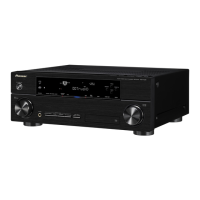
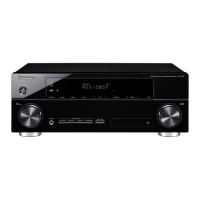
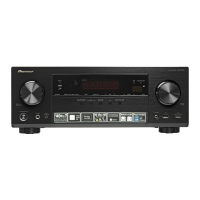

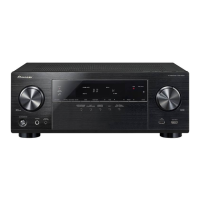
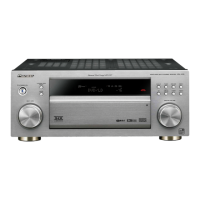

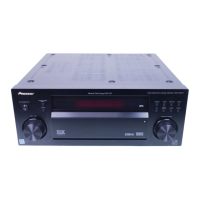
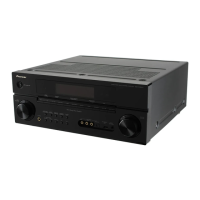
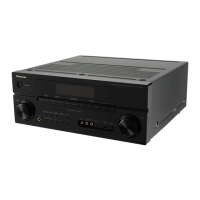
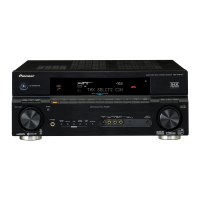
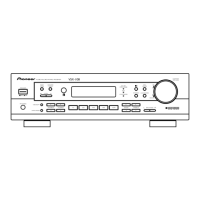
